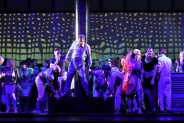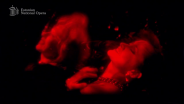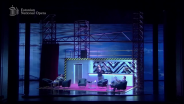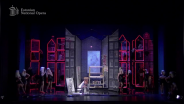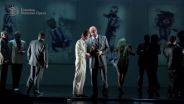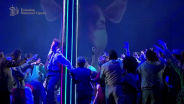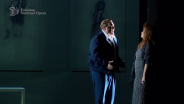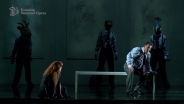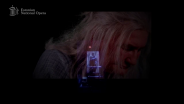Der fliegende Holländer
Der fliegende Holländer realised for Estonian National OperaDer fliegende Holländer
The ‘Flying Dutchman’, a modern high-flying businessman in the egotistic capitalist climate of the 1980s, is an alienated, manic-depressive man. His schizophrenic personality is constantly nourished by the necessity to overreach himself, which is followed inevitably by his seeking redemption from the consequences of his transgressions. This affects his life dramatically as he both desires salvation but seeks to escape from his redeemer, as he can’t live a life without his vices – a paradigm both of the self-perpetuating desire and commodity neo-capitalism. It is the perpetual striving ambivalent force, which sustains Dutchman’s life; without the vain pursuit of fame and fortune he faces boredom, ennui, a loss of meaning, even ultimately death. This eternal agony between his longing for peace and its refusal, leads him to his perennial disillusion: he can no longer enjoy his vices/transgressions and he can’t escape from them, even after numerous attempts. The opera’s theme of endless and aimless sailing is the metaphor of his modern/consumerist damnation.
In true Romantic fashion, Dutchman yearns for a homeland, which he has never actually known and therefore represents a utopian imaginative space that is more a state of mind that any real place. This vision is an unclear amalgam of his inchoate desires – for belonging, love, and the utopia of a fulfilling life. In the person of Senta and in her art he believes he perceives the only possibility of redemption.
Senta’s dream, passion and commitment become then a dramatic representation of the artist’s condition in symbolic terms, in which Dutchman recognizes his yearned for salvation. What Senta represents - a youthful, naive belief in art and creative expression - becomes trivialized and brutalized from a consumerist and capitalistic society.
In this confrontation, the symptoms of his never-ending dissatisfaction are shaken into desiring change. Is salvation possible through a simple philanthropic gesture? Is it possible for Dutchman to protect the unique nature of Senta and change his vices into a passion for virtue? Is the capitalistic society and the emergent “culture industry”, which he in his sickness represents, still able to find a way of redemption through art and authentic idealism? For Dutchman, it seems, any deceptive vice is more persuasive than artistic truth.
Press comments
Pamela Recinella staging strives to be an innovative, daring, dynamic, entertaining and visual production and will remain the most time on the level of her task. The beginning of the performance is powerful, perhaps the most powerful, what the walls of the 103-year old Estonian theatre building has ever seen. The giant three-dimensional moving in slow motion sea waves projected in the front as well as behind of the stage rhyme together with lighting design is combined wonderfully during the ouverture. This works perfectly with ideas of Wagner's opera themes and environment, musical tempos and moods, by interpreting them into the visual language in inventive and enchanting way.
Recinella lavastuses on ideid, fantaasiat, julgust ning kunstilist maitset.
Recinella staging has ideas, fantasy, courage and artistic taste.
Avavaatuse kunstilise lahenduse musikaalsus, visuaalne rikkus, maitsekus ning stiilipuhtus loid pahviks. Vaheajal jalutussaali komberdades avastasin ühtlasi, et olen natuke merehaigeks jäänuh.
The artistic solutions of the opening act just carried me away with its musicality, the visual richness, elegance and purity of style.In the intermission I detected myself, that I got a little bit seasick.


